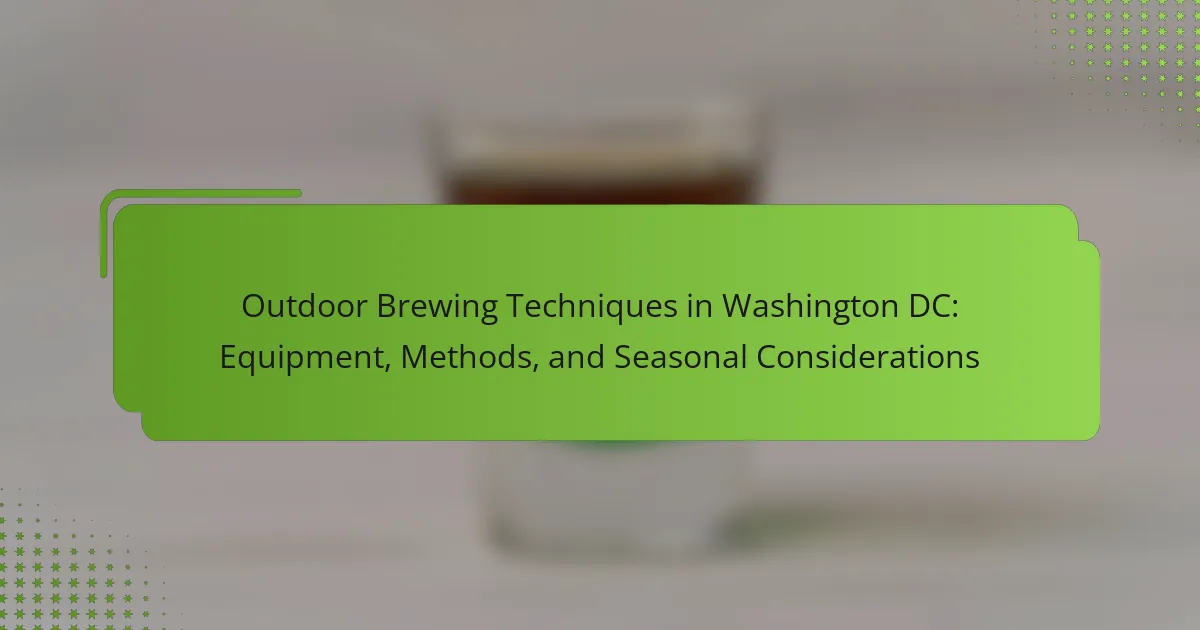Outdoor brewing techniques in Washington DC encompass various methods such as all-grain brewing, partial mash brewing, and extract brewing. All-grain brewing provides complete control over the beer’s flavor through the use of malted grains, while partial mash brewing offers a blend of simplicity and customization by combining malt extract with a small amount of grains. Extract brewing, the most accessible method for beginners, relies on pre-processed malt extracts. Seasonal factors play a significant role in brewing practices, with preferences shifting towards lighter beers in warmer months and richer styles during cooler periods. Additionally, local regulations may necessitate permits for certain outdoor brewing activities.

What are Outdoor Brewing Techniques in Washington DC?
Outdoor brewing techniques in Washington DC include methods like all-grain brewing, partial mash brewing, and extract brewing. All-grain brewing utilizes malted grains, allowing for full control over the beer’s flavor profile. Partial mash brewing combines malt extract with a small amount of grains, offering a balance between simplicity and customization. Extract brewing uses pre-processed malt extracts, making it the easiest method for beginners. Seasonal considerations affect brewing practices, with warmer months favoring lighter beers and cooler months encouraging richer styles. Local regulations may also influence outdoor brewing, requiring permits for certain activities.
How do outdoor brewing techniques differ from traditional methods?
Outdoor brewing techniques differ from traditional methods primarily in their use of natural elements. Outdoor brewing often incorporates ambient temperature and weather conditions, influencing fermentation and cooling processes. Traditional brewing typically relies on controlled indoor environments for consistency.
Outdoor methods may utilize open flames or camp stoves, while traditional brewing often uses electric or gas-powered equipment. Additionally, outdoor brewing tends to emphasize simplicity and portability. This is evident in the use of lightweight gear designed for mobility.
Research indicates that outdoor brewing can lead to unique flavor profiles due to environmental factors. Variability in temperature and humidity can enhance or alter the brewing process. This contrasts with traditional methods that aim for uniformity and precision.
What specific outdoor brewing methods are popular in Washington DC?
Popular outdoor brewing methods in Washington DC include all-grain brewing, partial mash brewing, and extract brewing. All-grain brewing involves using malted grains and water to create wort. This method is favored for its control over flavor and ingredients. Partial mash brewing combines malt extract with a small amount of grains. It offers a balance between simplicity and flavor complexity. Extract brewing relies on pre-made malt extract, making it accessible for beginners. Each method is suitable for outdoor settings, allowing enthusiasts to brew in parks or backyards. Local homebrew clubs often showcase these techniques during community events.
How do environmental factors influence outdoor brewing techniques?
Environmental factors significantly influence outdoor brewing techniques. Temperature affects fermentation rates. Higher temperatures can accelerate yeast activity, while lower temperatures may slow it down. Humidity levels impact the drying of ingredients like hops and grains. Wind can also affect temperature stability during the brewing process. Additionally, elevation alters boiling points, which can change extraction efficiency. Seasonal changes dictate ingredient availability and brewing styles. For instance, summer may favor lighter beers, while winter might encourage heavier stouts. These factors collectively shape the brewing process and final product.
What equipment is necessary for outdoor brewing in Washington DC?
The necessary equipment for outdoor brewing in Washington DC includes a brewing kettle, fermentation vessel, and heat source. A brewing kettle is essential for boiling the wort. A fermentation vessel is required for yeast activity and carbonation. A heat source, such as a propane burner, is needed for boiling. Additionally, a thermometer and hydrometer are important for monitoring temperature and specific gravity. Sanitizing equipment is crucial to prevent contamination. Lastly, a cooling system, like an immersion chiller, is useful for rapidly cooling the wort after boiling. These tools ensure a successful brewing process outdoors.
What are the essential tools and gear for outdoor brewing?
The essential tools and gear for outdoor brewing include a portable brewing system, a heat source, and fermentation vessels. A portable brewing system allows for efficient brewing away from home. A heat source, such as a propane burner, provides the necessary heat for boiling. Fermentation vessels, like carboys or buckets, are crucial for the fermentation process. Additionally, a thermometer ensures proper temperature control during brewing. A hydrometer measures the specific gravity of the brew. Sanitizing equipment is necessary to prevent contamination. Lastly, a cooler is useful for storing ingredients and keeping the brew at optimal temperatures.
How does the choice of equipment affect brewing outcomes?
The choice of equipment significantly impacts brewing outcomes. Different brewing equipment affects temperature control, extraction efficiency, and flavor development. For instance, a high-quality kettle maintains consistent heat, which is crucial for proper boiling and hop utilization. A well-designed mash tun ensures effective grain extraction, influencing the beer’s body and mouthfeel. Additionally, using a precise fermentation vessel can enhance yeast performance, leading to better flavor profiles. Studies show that equipment variations can result in noticeable differences in final product quality. Therefore, selecting appropriate brewing equipment is essential for achieving desired brewing results.
What seasonal considerations should be taken into account for outdoor brewing?
Seasonal considerations for outdoor brewing include temperature, humidity, and daylight hours. Temperature affects fermentation and boiling processes. Ideal brewing temperatures range from 65°F to 75°F. High temperatures can lead to off-flavors in beer. Low temperatures may slow fermentation rates.
Humidity levels impact the brewing environment. High humidity can lead to issues with mold and spoilage. Conversely, low humidity may cause evaporation of water during the boiling process.
Daylight hours influence brewing schedules. Longer days in summer allow for more flexibility in brewing times. Shorter days in winter may require adjustments to maintain optimal brewing conditions.
Weather conditions also play a role. Rain can disrupt outdoor brewing setups. Wind may affect heating elements and cooling processes. Planning for seasonal changes ensures a successful brewing experience.
How do different seasons impact brewing processes and flavors?
Different seasons significantly impact brewing processes and flavors. Temperature affects fermentation rates, with warmer months speeding up yeast activity. In winter, cooler temperatures can slow fermentation and enhance flavor complexity. Seasonal ingredients also influence flavor profiles. For example, summer may favor lighter, refreshing brews, while autumn encourages richer, maltier options. Additionally, humidity levels can affect the brewing environment, influencing hop utilization and overall taste. Historical practices show that seasonal variations have shaped regional brewing styles, such as winter ales and summer lagers.
What precautions should brewers take during extreme weather conditions?
Brewers should implement several precautions during extreme weather conditions to ensure product quality and safety. They must monitor temperature and humidity levels closely. Maintaining optimal fermentation temperatures is crucial to prevent off-flavors. Brewers should also secure outdoor equipment against high winds and heavy rain. Proper insulation of brewing vessels can protect against freezing temperatures. Additionally, using heat sources like blankets or heaters can help maintain warmth during cold spells. During excessive heat, brewers should ensure adequate cooling systems are in place. These measures help maintain the integrity of the brewing process and the final product.
How can brewers optimize their outdoor brewing experience?
Brewers can optimize their outdoor brewing experience by selecting appropriate equipment and planning for environmental factors. Using portable brewing systems allows for flexibility in location. Insulated coolers help maintain temperature control for ingredients. Additionally, brewers should consider windbreaks to protect their setup from strong gusts. Proper lighting is essential for evening brewing sessions. They can also use tarps or tents to shield from rain or excessive sun. Timing brewing sessions to avoid extreme weather enhances the overall experience. These strategies ensure a more efficient and enjoyable outdoor brewing process.
What tips can enhance the outdoor brewing process in Washington DC?
Use high-quality ingredients for outdoor brewing in Washington DC. Fresh hops and specialty malts improve flavor and aroma. Maintain a consistent temperature during brewing. This ensures proper fermentation and enhances the final product. Utilize a portable brewing setup for convenience. A compact system allows for easy transport to various outdoor locations. Monitor weather conditions closely. Washington DC can experience humidity and temperature fluctuations that affect brewing. Consider using a windscreen for your brewing equipment. This minimizes heat loss and maintains efficiency. Lastly, keep sanitation practices top-notch. Clean equipment prevents contamination and ensures a successful brew.
How can brewers troubleshoot common outdoor brewing challenges?
Brewers can troubleshoot common outdoor brewing challenges by assessing environmental factors and adjusting their techniques accordingly. First, they should monitor temperature fluctuations, as extreme heat or cold can affect fermentation. For example, using insulated coolers can help maintain a stable temperature.
Next, brewers need to ensure proper sanitation in outdoor settings. They can carry portable sanitizing equipment to prevent contamination from outdoor elements. Additionally, wind can impact flame stability; using windshields can provide protection for burners.
Rain poses another challenge; brewers can use tarps or canopies to keep equipment dry. Lastly, they should be prepared for unexpected wildlife interference by securing food and ingredients. These strategies help maintain quality and consistency in outdoor brewing.
Outdoor brewing techniques in Washington DC encompass various methods such as all-grain brewing, partial mash brewing, and extract brewing, each offering unique benefits and levels of complexity. The article delves into how these outdoor methods differ from traditional brewing, emphasizing the influence of environmental factors like temperature and humidity on the brewing process. It also outlines essential equipment needed for successful outdoor brewing, seasonal considerations that affect brewing styles, and practical tips for optimizing the outdoor brewing experience while addressing common challenges.
